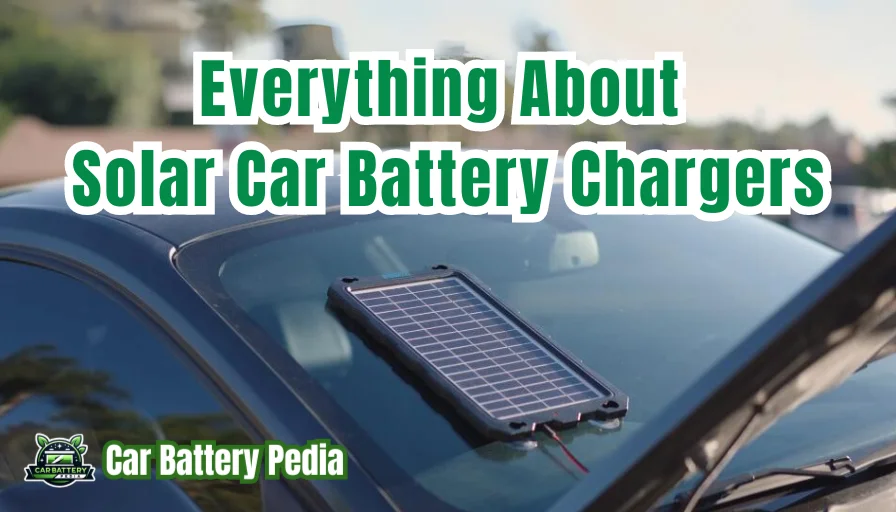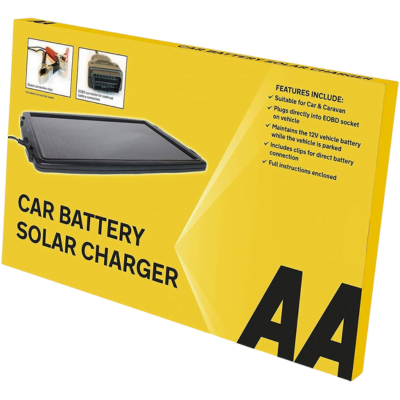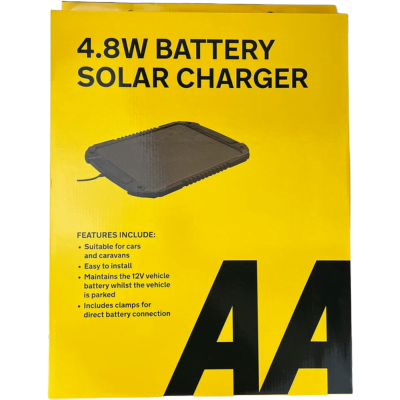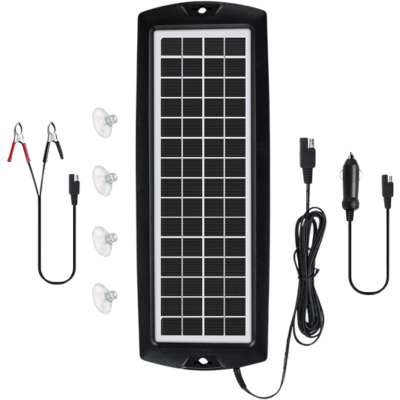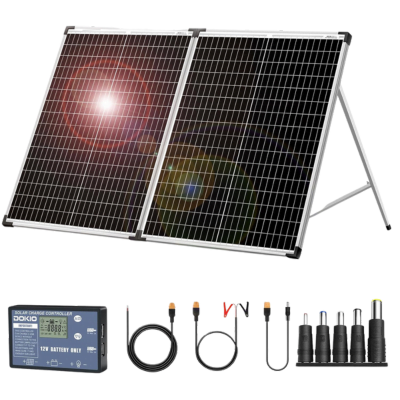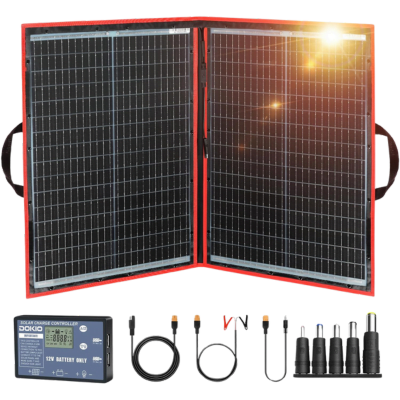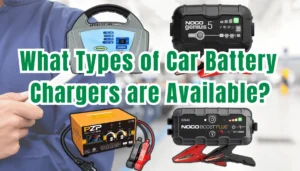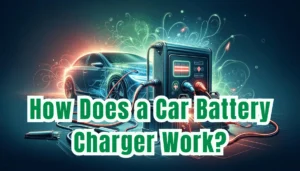Table of Contents
Introduction to Solar Car Battery Chargers
Have you ever worried about your car’s battery dying when you haven’t used it for a while? Or you’ve thought about how cool it would be to use the sun’s power to keep your car running smoothly. Well, solar car battery chargers are here to save the day, and they’re pretty amazing gadgets that do just that!
Imagine a small solar panel that you can attach to your car. This panel captures sunlight and turns it into electricity, keeping your car’s battery charged. It’s like giving your car a tiny, endless energy supply from the sun! This is especially handy if you don’t drive your car every day because it helps make sure your car will start when you need it to.
Solar-powered car battery chargers are an eco-friendly option for car owners. Using solar power means we’re relying less on electricity from power plants that can harm the environment. Plus, it’s like having your own mini power station right on your dashboard or windshield!
In this guide, you’ll learn everything you need about solar car battery chargers. We’ll look at how they work, why they’re useful, and what makes them so cool. Whether you’re a car enthusiast or just curious about solar energy, there’s something exciting to learn about powering your ride with sunshine!
Part 1: Understanding Solar Car Battery Chargers
Let’s simplify what solar car battery chargers are and how they function, making it easy to understand.
What is a Solar Car Battery Charger?
A solar car battery charger is a device that uses the sun’s power to keep your car’s battery charged and ready to go. You probably remember the small panel on calculators; it is like that. But instead of powering a calculator, this panel charges your car’s battery.
How Does a Solar Charger Work?
The process is pretty straightforward. The solar panel collects sunlight and converts it into electrical energy. This energy then flows through a cable into your car’s battery. It’s like how plants use sunlight to make food for themselves in a process called photosynthesis.
A solar panel is a device made up of many smaller units called solar cells, usually made from a material like silicon, which is good at absorbing light.
Solar cells, also known as photovoltaic (PV) cells, are the building blocks of solar panels. They’re designed to convert sunlight directly into electricity. Here’s a simple breakdown of how they work:
- Material: Most solar cells are made from silicon, which is a semiconductor. This means it can conduct electricity under certain conditions.
- Sunlight Interaction: When sunlight hits a solar cell, the energy from the light, including photons (light particles), is absorbed by the silicon.
- Electron Movement: This energy excites the electrons (tiny particles with negative charge) in the silicon, causing them to move freely.
- Electric Current: These free-moving electrons are captured to form an electric current, which is used to power devices, homes, or businesses.
- Electricity Generation: The current, together with the cell’s voltage (which is a result of its built-in electric field or fields), defines the power (or wattage) that the cell can produce.
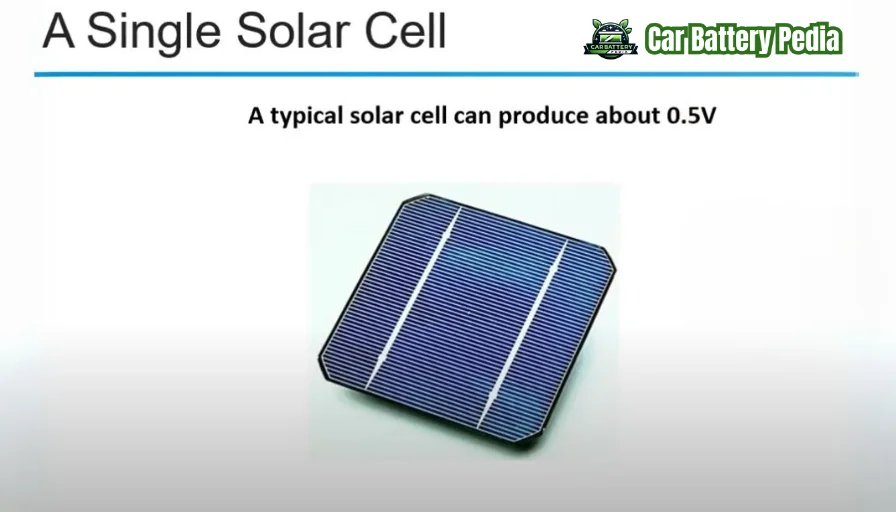
Each solar cell has a typical voltage when exposed to sunlight, and for most silicon cells, this is about 0.5 to 0.6 volts under standard conditions. If the cell size is larger, the voltage doesn’t change. However, if the cell size is larger, more current will be generated. But, the actual voltage and current can vary based on the cell’s design and the intensity of sunlight.
If we combine solar cells as a panel, we can achieve more voltage. A panel manufactured with 36 solar cells can produce 18-22 volts of electricity. The power value (Watt) of a solar panel charger is determined by the size of the cells or the connection types in the panel—parallel or serial connections between cells.
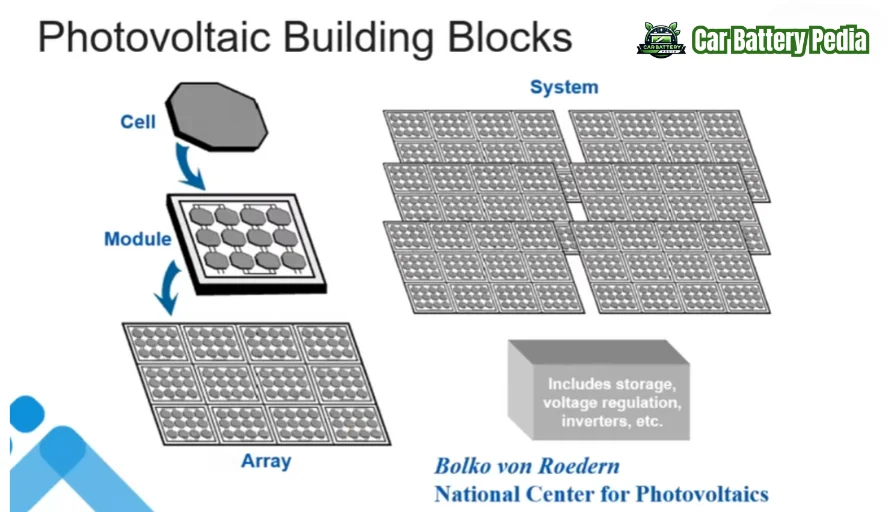
A cool feature about them is that these solar panels and chargers can still gather solar energy even on days when it’s not super sunny. They don’t need direct sunlight all the time to work, which makes them pretty handy, especially if you live in a place where it’s not always bright and sunny.
Why Use a Solar Car Battery Charger?
There are a few good reasons to use one of these chargers:
- Keeps Your Battery Healthy: If you don’t drive your car often, the battery can lose charge over time. A solar charger keeps it charged up.
- Saves Money: Using the sun’s free energy means you don’t have to pay to charge your battery. Over time, this can save you some cash.
- Eco-Friendly: Solar power is clean and renewable, which means it’s good for the planet because it reduces the need for electricity from non-renewable sources that can harm the environment.
Part 2: Exploring Solar Charger Efficiency
Now, what is solar charger efficiency? This is all about how well your solar charger turns sunlight into the energy your car’s battery can use.
What is Solar Charger Efficiency?
Efficiency in solar chargers refers to how good they are at converting sunlight into electrical power. A more efficient solar charger can capture more sunlight and turn it into more power for your car’s battery, even when the sun isn’t shining.
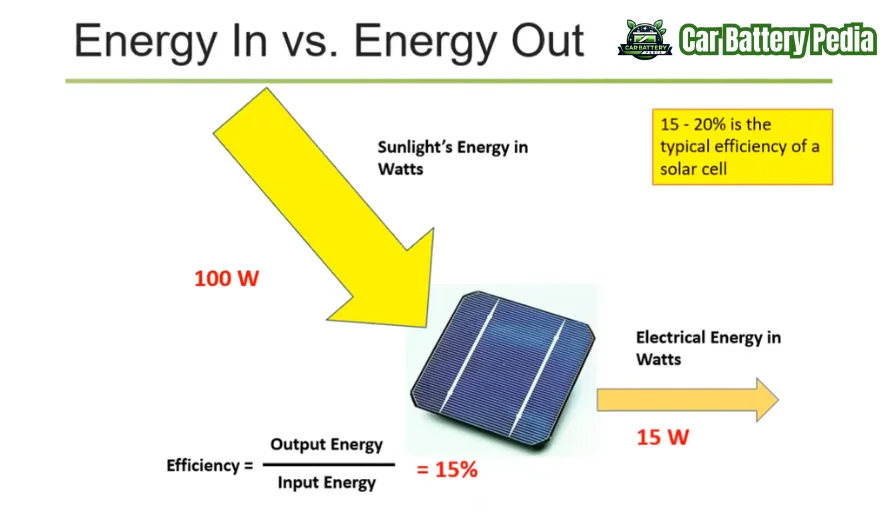
There is an important point here: When we are talking about efficiency, we need to know that there are two types of efficiency in solar charging. One is solar cell efficiency, which is the efficiancy of only one cell, and the other is solar panel efficiency, which is a panel produced from many solar cells.
We are interested in solar panel efficiency. Solar cell efficiency is measured only in a laboratory environment, and the efficiency of just one solar cell does not indicate the efficiency of a solar panel.
Why is Efficiency Important?
Efficiency matters because:
- More Power: The more efficient a solar charger is, the more power it can provide to your car’s battery, keeping it charged and ready to use.
- Faster Charging: Efficient solar chargers can charge your battery quicker, which is really handy if you need to get your car running in a short amount of time.
- Better in All Weather: Even on cloudy or not-so-sunny days, an efficient solar charger can still gather enough sunlight to charge your battery.
Here are some numbers and percentages that can help you get some rough information about solar battery chargers’ efficiency.
- Average Efficiency Rates: Most solar panels used in solar car battery chargers have an efficiency rate of around 15% to 20%. This means they can convert 15% to 20% of the sunlight they receive into usable electrical energy.
- High-Efficiency Solar Panels: Some high-end solar panels can achieve efficiency rates of up to 22% to 25%. These panels use advanced technologies and materials to capture more sunlight and convert it into energy more effectively.
- Effect of Conditions: A solar charger’s efficiency can drop in suboptimal conditions. For instance, if a solar panel is partially shaded, its efficiency might decrease significantly. On a cloudy day, the efficiency might drop to 10% to 15%, depending on the quality of the solar panel and its ability to capture diffused sunlight.
- Comparison with Household Solar Panels: To put it in perspective, household solar panels typically have efficiencies between 18% and 22%. The solar panels used in car battery chargers are usually smaller and more portable, which sometimes means a slight compromise in efficiency compared to their larger household counterparts.
| Efficiency | Weather Condition | Battery Capacity | After Charging 1 Hour |
|---|---|---|---|
| 15% | Sunny | 60% | 69% |
| 20% | Sunny | 60% | 72% |
In this table chart above, I demostrate simply how the solar panel efficiency affects the charging difference in the same conditions.
Factors Affecting Solar Charger Efficiency
Several things can influence how efficient a solar charger is, like:
- Quality of Solar Panels: High-quality solar panels can capture more sunlight and convert it into energy more effectively.
- Angle and Placement: How and where you place your solar charger can affect how much sunlight it gets and how well it works.
- Technology Used: Some solar chargers have advanced technology that helps them work better in different light conditions.
- Regional Location: Solar chargers’ performance may vary based on regional location. The image, titled ‘US Annual Average Daily Total Solar Resources Using 1998-2016 Data,’ showcases a map detailed with colour coding to indicate the intensity of solar radiation received in different regions.

What types of Solar Panels are Available According to Their Quality and Technology?
Here’s a breakdown of the most common types used in various applications, including solar car battery chargers:
Monocrystalline Solar Panels

Made from single-crystal silicon, making them highly efficient and durable.
Efficiency rates typically range from 15% to 20%, with some models reaching over 22%. They perform well in low-light conditions and take up less space because of their high efficiency.
Usually more expensive due to their high quality and efficiency.
Polycrystalline Solar Panels
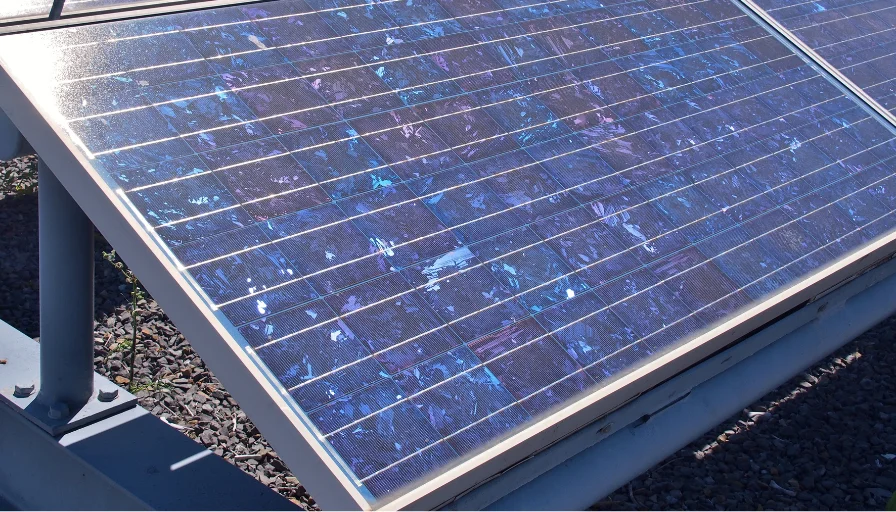
They are constructed from multiple silicon crystals, which gives them a distinctive blue, speckled appearance. Generally, they have lower efficiency rates than monocrystalline panels, typically between 13% and 18%.
It is less expensive than monocrystalline panels but also slightly less efficient and has a shorter lifespan.
Thin-Film Solar Panels
Made by depositing one or more layers of photovoltaic material (like amorphous silicon, cadmium telluride, or CIGS) on a substrate.
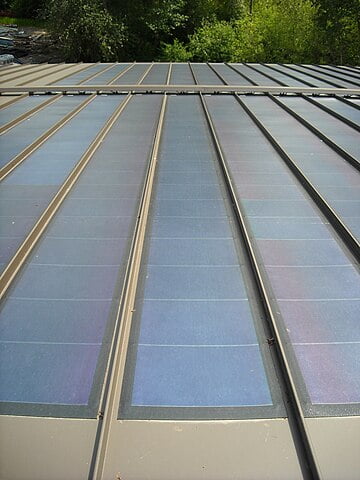
These panels have efficiency rates that are close to those of polycrystalline solar panels, usually between 10% and 18%. They are also lighter, more flexible, and cheaper to produce than crystalline silicon panels.
Often used in large-scale installations or situations where weight and flexibility are important.
Amorphous Silicon Solar Panels
A type of thin-film solar panel that uses amorphous silicon is non-crystalline. These have lower efficiency, around 7% to 10%, but can perform better in low-light conditions compared to other types.
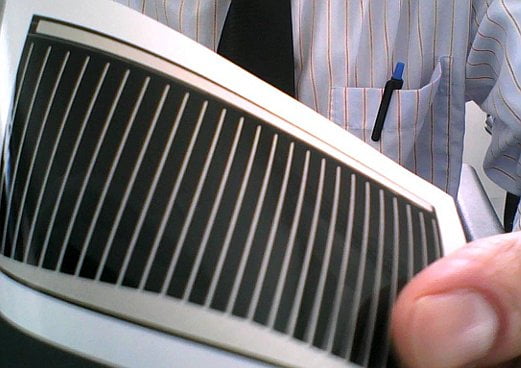
Commonly used in smaller applications like calculators, watches, and portable solar chargers due to their flexibility and lightweight nature.
Concentrated PV Cell (CPV)
Uses lenses or curved mirrors to concentrate sunlight onto small but highly efficient photovoltaic cells. Can achieve efficiency levels higher than 40% in ideal conditions.

More common in industrial or commercial solar projects due to their complex setup and need for solar tracking systems to maximize sunlight capture.
Monocrystalline and polycrystalline panels are most commonly used for solar car battery chargers because they balance efficiency, cost, and size. Thin-film panels might also be used in portable or flexible charger designs, where their lightweight and adaptable nature can be advantageous.
If you need more details about solar panels, please visit the link below.
Maximizing Efficiency
To get the most out of your solar charger, consider these tips:
- Proper Placement: Position your solar charger where it gets direct sunlight for the longest part of the day.
- Regular Cleaning: Keep the solar panel clean from dust and dirt, as this can block sunlight and reduce efficiency.
- Choose Quality: Opt for a solar charger with good reviews and proven performance to ensure you get a device that can efficiently convert sunlight into energy.
In summary, solar charger efficiency is all about how well your charger can convert sunlight into electrical power for your car’s battery. The more efficient your charger, the better it will perform, especially on less sunny days.
Part 3: Solar Trickle Chargers – The Gentle Power Keepers
Let’s examine solar trickle chargers, a type of solar car battery charger that gives your car’s battery a gentle, continuous charge.
What’s a Solar Trickle Charger?
Think of a solar trickle charger as a patient helper that gives your car’s battery just a little bit of power at a time. It’s a solar charger that makes sure your battery stays full, but it does so very slowly to prevent overcharging.
How Do Solar Trickle Chargers Work?
Solar trickle chargers are pretty neat in how they keep your battery happy:
- Slow and Steady Charging: They add power to your battery very slowly, matching the rate at which the battery naturally loses charge. This means your battery stays full without getting too much juice.
- Smart Power Control: These chargers are smart enough to know not to give the battery too much power, which helps keep the battery safe and in good shape.
Why Are Solar Trickle Chargers Awesome?
Solar trickle chargers are great for a few reasons:
- They Keep Your Battery Healthy: By charging slowly, they help your battery last longer by preventing it from ever running empty or getting overcharged.
- Super Convenient: You can keep them connected constantly without worrying about damaging the battery, making them perfect for cars that aren’t driven daily.
- Always Ready: They make sure your car is always ready to start, avoiding the stress of finding your battery dead when you really need to go somewhere.
Solar trickle chargers are especially handy for a car not used daily, like a spare car at home or a vehicle you might only use for weekend trips. Maybe you’ve got a motorhome (RV).
These chargers are the best option for all these situations. They ensure that even if your car or motorhome sits unused for a while, the battery will still be full and ready to go when you need it.
In short, solar trickle chargers are a full pack of solar car battery charger that provides a gentle, ongoing charge to keep your car’s battery in top condition. They’re a smart choice for keeping your battery charged safely and efficiently over time.
Which Solar Trickle Chargers do I suggest?
I’ve searched for many solar trickle car battery chargers on Amazon. The criteria that I considered while I was searching were user-friendliness, durability, reliability, and price, according to customer reviews and my personal experiences. And I ended up with two options below.
- Solar Trickle Charger for leaving it on the dashboard and forgetting it until driving again. The charging process is so slow with this charger.
- Solar Trickle Charger, which we should check out during the day during battery charging. The charging process will take around 6-10 hours.
Option 1— This option for the people who lives in a mostly sunny place. These solar trickle chargers have the lowest output power, around 5-10 watts and 0.20-1 amps at maximum 20-23 volts. They maintain the battery for all the time the car is not being used. Also, we leave them inside the car without checking them so opten. Because of that, we have to be cautious about the electronic system breaking down inside the solar panel or wires burning because of the high amps.
Another important option that this type of charger must have is the EOBD Connector. If the cigarette lighter sockets do not work constantly, as in new cars, you will not be able to charge your car’s battery after locking it. On newer cars, the OBD socket is also disabled. Therefore, before leaving the solar panel in the car, you need to make sure that the OBD socket is constantly working.
So, according to my detailed searches, the best options for UK users are the AA Solar Battery Charger 2.4 Watt and 4.8 Watt below.
A few different companies are selling the same products at different prices, but these are below directly from AA’s Amazon shop, and they are a few pounds cheaper. Probably others buy from AA and sell them at their own shop for a few pounds profit.
If you are not in Summer, an AA 2.4-watt Solar Charger might not be suitable for the UK. The UK doesn’t have many clear sunny days to charge with the lower-wattage solar panels.
I have an AA 2.4-watt Solar Charger. It produces 21 volts and 0.22 amps on clear sunny days, more than 4 watts. But it doesn’t help much if there are few clear sunny days. If I leave it in the car for a few days when there are a few sunny days, it drains the battery slowly.
The best option for US users is the Sunway Solar Trickle Charger 5 Watt below. This charger also has 1.5 Watt, 4 Watt, and 8 Watt power options. 1.5 Watts might be too low, but it works great, according to an electrical engineer’s detailed review.
But, the Sunway Solar Trickle Charger doesn’t have an EOBD Connector. I suggest you get a separate one if you don’t want to use terminal connectors to connect it directly to the 12V battery. The adapter below will fully satisfy you to connect the Sunway Solar Trickle Charger to the OBD socket for in-car charging.
Option 2—The second option type is for more powerful solar trickle chargers, with options ranging from 10 watts to 30 watts. The choice depends on where you use it because they are quite bigger than the Option-1 solar trickle chargers.
My suggestion about Option 2— trickle chargers are Voltset Solar Trickle Chargers. Generally, if the solar charger’s power is more than 5 watts, you need to use a charger controller between the solar panel and car battery to prevent overcharging. But these solar chargers below already have built-in charger controllers, so you don’t need to add an extra controller.
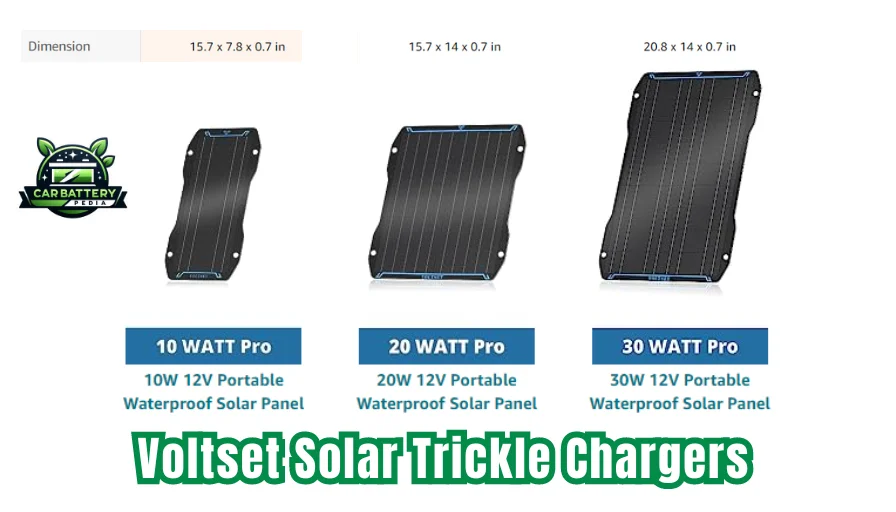
These solar chargers are big but extremely lightweight. So they have a portability advantage. They were released in 2023 and have many professional reviews.
Recently, they have had a 10% discount coupon on Amazon UK and a 30% discount coupon on Amazon US.

Voltset 10W 12V Portable Solar Trickle Charger

Voltset 20W 12V Portable Solar Trickle Charger
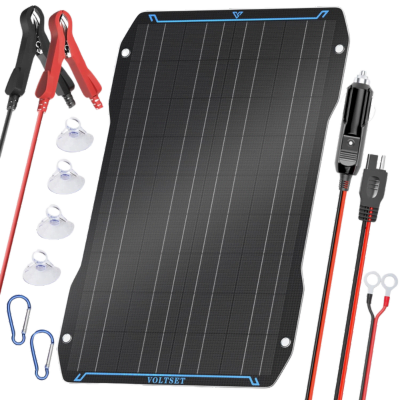
Voltset 30W 12V Portable Solar Trickle Charger
Part 4: Why Charge Controllers Are Important for Solar Car Battery Chargers
Let’s talk about something really important in solar car battery chargers: it is charge controllers.
If your solar charger isn’t a trickle charger, having a charge controller is necessary to keep your car’s battery safe and happy.
What is a Charge Controller?
A charge controller is like a smart manager for your solar charger. It controls how much electricity goes from the solar panel to your car’s battery. Its job is to make sure the battery gets the right amount of power and doesn’t get too much, which could damage it.
Why Do We Need Charge Controllers?
Here’s why charge controllers are super important:
- Prevents Overcharging: If a battery gets more power than it needs, it can get damaged. A charge controller stops this by limiting the amount of power going to the battery.
- Extends Battery Life: The charge controller helps your battery last longer by keeping it from overcharging. This is great because you won’t need to replace it as often.
- Increases Safety: Too much charge can not only damage the battery but can also be dangerous. Even wires which go to the battery from the solar panel might get burned from the flowing electricity without a charge controller. The charge controller helps keep everything safe by managing the power flow properly.
How Does a Charge Controller Work?
A charge controller is like a gatekeeper. It constantly checks the battery’s capacity and adjusts the power flowing into it. If the battery is getting full, the charge controller slows down the electricity flow to just the right level.
While trickle chargers automatically charge the battery slowly and carefully, other solar chargers might give a lot of power at once. That’s where a charge controller comes in handy. It ensures that even if the solar panel is collecting a lot of sunlight and creating a lot of energy, it only sends what it can handle to the battery.
Which Powerful Solar Panel with a Charge Controller do I Suggest?
Using a charge controller, you can use a powerful solar panel like 50W-100W solar panels to charge your car/campervan batteries.
If you are looking for a powerful solar panel charger, I suggest you get these below.
For the UK – DOKIO 100 Watt Foldable Monocrystalline Solar Panel below. It gives the exact amount of output power that it claims. Also, I haven’t come across any burning issues with this product during my searches.
For the US – DOKIO 110W Lightweight Portable Solar Panel. It gives the overall output that it claims even more. Many lightweight, thin film solar panels give around 60-80% of their claimed full power, according to customer reviews in the US. But for Australia, this percentage probably will be more than 90%.
Part 5: Installation of Solar Trickle Chargers and Solar Chargers with Controllers
Understanding how to install solar trickle chargers and solar chargers with controllers can significantly affect their effectiveness and safety. Here’s a detailed look at installing both types of chargers:
Installing Solar Trickle Chargers
- Positioning the Panel: Place the solar panel where it will receive maximum sunlight, such as on the dashboard inside the car or mounted externally on the roof.
- Connecting to the Battery: Connect the wires from the solar panel to the car battery. The positive wire goes to the positive terminal, and the negative wire goes to the negative terminal. Most trickle chargers come with clips or O-rings for easy attachment.
- Routing the Wires: Ensure the wires are neatly routed to prevent damage and disconnection. If necessary, use cable ties to secure them.
- Checking for Exposure: Make sure the panel is positioned to catch sunlight for most of the day. Adjust the angle if needed, especially if you’re changing seasons.
Safety Tips:
- Ensure the connections are tight and secure to prevent sparks or disconnections.
- Check periodically that the panel is clean and debris-free to maintain optimal performance.
Installing Solar Chargers with Controllers
If you decide to buy solar panels and solar charge controllers separately, this is how you install the system. Also, I’d like to suggest the controller below for you as a good charge controller.

Solar Charge Controller
- Choosing the Right Location: Find a spot where the solar panel will get direct sunlight most of the day. This could be on a garage roof, a yard stand, or another sunny location.
- Mounting the Panel: If you have a big panel, securely mount the solar panel using brackets or a mounting kit. Depending on your geographic location, make sure it’s angled to maximize sun exposure.
- Installing the Charge Controller: The controller should be installed between the solar panel and the battery. Mount the controller in a location close to the battery but protected from the elements.
- Wiring Connections and Setting Up the Controller: Connect the battery first to the output terminals on the charge controller and then set up the controller for the correct battery type and parameters using the controller’s user manual. Then, connect the solar charger to the input terminals. Pay close attention to correct polarity to avoid any electrical mishaps.
- System Check: Once everything is connected, check the entire system to ensure it’s operating correctly. Monitor the charge controller’s display to see that it’s regulating the charge properly.
Watch the video below to learn more about connecting and adjusting the solar charger controller.
Safety Tips:
- Use appropriate gauge wires to handle the electrical current and prevent overheating.
- Regularly inspect all connections and mounts to ensure they remain secure and functional over time.
- Keep the charge controller in a ventilated space to prevent overheating.
Part 6: Portability Advantages of Solar Chargers
Now, let’s focus on the portability of solar chargers, which are super handy for keeping your car’s battery charged no matter where you are!
What Does Portability Mean for Solar Chargers?
Solar car battery chargers are lightweight and compact, so they are easy to move around and use wherever you need them without an electricity plug. You can carry them and use them in different places, not just get stuck in one spot, and you don’t need electricity.
Why Portable Solar Chargers are so Useful?
These chargers are fantastic for several reasons:
- Take Them Anywhere: Because they’re portable, you can use them in different places, not just at home. They’re great for road trips, camping, or even in your backyard.
- Easy to Use: They often come with clips or suction cups, so you can attach them to your car’s windshield, dashboard, or even on the roof, making them super easy to set up.
- No Plugs Needed: They don’t need to be plugged into an electrical outlet. As long as there’s sunlight, they can charge your battery, giving you freedom and convenience.
Great for Emergencies
What’s really cool about portable solar chargers is that they can be lifesavers in emergencies. If your car’s battery loses energy while you’re out and about, you can whip out your portable charger, soak up some sun, and get enough charge to start your car again.
In summary, portable solar chargers are a fantastic tool for anyone who loves to be on the move or needs a reliable backup power source for their car. They’re easy to carry around and simple to use, and they can charge your car’s battery wherever you find sunshine. For anyone who’s into road trips or outdoor adventures or just wants to be prepared, a portable solar charger is a must-have gadget.
Part 7: The Advantages of Weatherproof Solar Chargers
What Makes Solar Chargers Weatherproof?
Weatherproof solar chargers are built to withstand various weather conditions, from scorching sun to heavy rain. They’re designed with materials that protect them from water damage, extreme temperatures, and even dust or dirt. This durability means they can keep working effectively no matter what the weather throws at them.
Key Features to Look For
When choosing a weatherproof solar charger, consider these features:
- Water Resistance: Look for chargers rated with an IP (Ingress Protection) code, which tells you how well the charger can resist water and dust. The higher the number, the better the protection.
- UV Protection: Chargers exposed to a lot of sunlight should be made of UV-resistant materials to prevent wear and tear from the sun’s rays.
- Temperature Tolerance: A good weatherproof charger can operate efficiently in high and low temperatures.
The numbers and ratings give us a clear idea of how well they can withstand different environmental conditions:
- IP (Ingress Protection) Rating: This rating measures how well the device is protected against solid objects (like dust) and liquids (like water). For example, an IP rating of IP65 means the charger is dust-tight and can withstand water jets from any direction. The first digit after IP indicates the level of protection against solids (0-6), and the second digit indicates the level of protection against liquids (0-9).
- Operating Temperature Range: This indicates the temperature range within which the charger can operate safely and efficiently. For example, a solar charger might have an operating range of -20°C to 60°C (-4°F to 140°F), meaning it can work properly in very cold or very hot conditions without damage or loss of efficiency.
- UV Resistance: While there’s not always a specific number like the IP rating, UV-resistant chargers are designed to withstand prolonged exposure to ultraviolet light without degrading. The materials used in these chargers are tested for UV exposure and rated based on how long they can last under constant sunlight.
- Durability Tests: Some solar chargers undergo specific tests to simulate years of use in harsh conditions. For example, a charger might be certified to withstand 2,000 hours of salt spray mist, which simulates long-term exposure to salty coastal environments.
Real-Life Importance
Imagine you’re camping, and it starts to rain. With a weatherproof solar charger, you won’t have to rush to cover it up or worry about it getting damaged. It will keep working, charging your car’s battery and ready for your next adventure.
Part 8: Solar Charging Time: What to Expect
Understanding how long it takes to charge a car battery with a solar charger is important for managing your expectations and planning your usage. Let’s dive into the details and provide some numbers to give you a clearer picture.
Factors Influencing Solar Charging Time
Several factors affect how quickly a solar charger can recharge your car’s battery:
- Solar Panel Wattage: This is the power output of the solar panel, typically measured in watts (W). For example, a 15W solar charger will generally take longer to charge a battery than a 50W charger.
- Battery Capacity: Measured in ampere-hours (Ah), this indicates how much charge a battery can hold. A larger battery, say 100Ah, will take longer to charge than a smaller one, like a 50Ah battery.
- Sunlight Intensity: The amount of sunlight available directly impacts how efficiently a solar charger works. In full, direct sunlight charges faster than on a cloudy day.
Typical Charging Times
To give you an idea of charging times, let’s look at some scenarios:
- A 50W solar panel in direct sunlight can typically charge a standard car battery (around 48Ah) from 50% to 100% in about 5-8 hours
- For smaller batteries, like those in motorcycles or scooters (around 10-15Ah), a 15W solar charger might fully recharge the battery in approximately 4-6 hours under optimal sunlight.
Understanding the Numbers
Charging time is not just about the total hours; it’s also about how effectively those hours are used. Solar chargers are most efficient when the sun is at its peak, usually from 10 am to 4 pm. During these hours, a solar charger can operate at its maximum capacity.
Efficiency Over Time
Solar chargers don’t always work at their peak efficiency throughout the day. Here’s how efficiency typically varies:
- Morning (8 am – 10 am) and late afternoon (4 pm – 6 pm): Reduced efficiency due to the sun’s lower angle.
- Midday (10 am – 4 pm): Peak charging efficiency.
I have added two charts below to show the differences on an hourly basis during the day and on a seasonal basis.


In summary, the time it takes to charge a car battery with a solar charger depends on the charger’s wattage, the battery’s capacity, and the available sunlight. By understanding these factors and the typical numbers associated with them, you can better plan how and when to use your solar charger for optimal results.
Part 9: Cost-Effective Solar Charging
Solar car battery chargers are convenient and environmentally friendly, and they are also a cost-effective solution for maintaining your car’s battery health. Let’s explore how investing in a solar charger can save you money in the long run.
Savings on Electricity Costs
1. Reduced Dependency on Grid Power: Solar car battery chargers use the sun’s energy, which is completely free. By charging your car’s battery using solar power, you avoid using electricity from your home that would otherwise increase your utility bills.
2. Efficient Battery Maintenance: Maintaining a battery with solar power can extend its life, meaning you won’t need to replace it as often. Car batteries can be expensive, so extending the life of your existing battery saves money over time.
Initial Cost vs. Long-term Savings
1. Initial Investment: The initial cost of purchasing a solar charger varies depending on the type and capacity. Basic models might cost as little as $20-$50, while more advanced models with higher wattage and built-in controllers can range from $100 to $200.
2. Break-Even Point: Although there is an upfront cost, the savings from not having to replace your battery as frequently and reduced electricity bills can quickly cover the initial expense. For example, if a solar charger extends your battery’s life by two years and reduces your yearly electricity usage, the savings can exceed the cost of the charger within a couple of years.
Environmental Savings
1. Reduced Carbon Footprint: Using solar energy to charge your car’s battery reduces your reliance on fossil-fueled electricity, lowering your carbon footprint. This environmental saving may not directly translate into monetary value. Still, it contributes to broader societal benefits, such as reduced greenhouse gas emissions.
2. Decreased Resource Consumption: By extending the life of your car’s battery, solar chargers reduce the need for new batteries, which in turn decreases the demand for the raw materials needed to manufacture these batteries, many of which have significant environmental extraction impacts.
Comparing Costs with Traditional Charging
1. Traditional Charging Costs: Charging a car battery using standard electricity incurs costs related to electricity consumption. For instance, if a charger draws 2 amps at 12 volts over 5 hours, it uses 1.2 kilowatt-hours. Depending on your local electricity rates (say $0.13 per kilowatt-hour), this would cost about $0.16 per charge.
2. Solar Charging Costs: Once installed, solar chargers incur no ongoing costs. After overcoming the initial purchase price, the sun provides free energy, making it a cost-effective alternative.
In summary, solar car battery chargers offer significant cost advantages over time. They reduce ongoing energy costs, extend battery life, and contribute to environmental conservation. By switching to solar charging, you’re not just saving money; you’re also participating in a sustainable future.
Part 10: Solar Power for Vehicles: The Broader Context
Solar power for vehicles extends beyond just keeping the car battery charged. It represents a shift towards more sustainable and innovative energy solutions in the automotive industry. Let’s explore the broader implications and benefits of using solar energy for vehicles.
Integration of Solar Technology in Vehicles
1. Solar-Powered Vehicles: Some vehicles are now designed with solar panels integrated directly into their structures. For example, solar panels can be embedded in the roof, hood, and trunk of cars, providing additional power for the vehicle’s electrical systems or contributing to the driving power.
2. Auxiliary Power Uses: Beyond just charging the battery, solar power can run other vehicle systems, like air conditioning, lighting, and infotainment systems. This reduces the overall energy load on the engine and can lead to fuel savings in conventional vehicles or extended range in electric vehicles.
Advantages of Solar Power in Automotive Applications
1. Reduced Emissions: By using solar energy, vehicles reduce their reliance on fossil fuels, leading to lower emissions of CO2 and other harmful pollutants. This is crucial for tackling climate change and improving air quality.
2. Energy Independence: Solar power helps reduce dependence on the electrical grid and fossil fuels, providing drivers more autonomy and security in energy resources.
3. Innovations in Efficiency: As automotive manufacturers invest more in solar technology, we see innovations that increase the efficiency of solar panels and their integration into vehicle designs. This pushes the envelope on what’s possible in renewable energy applications in transportation.
Challenges and Future Prospects
1. Technological Challenges: Integrating solar panels that are efficient enough to power a vehicle’s primary systems without compromising design and performance is a significant challenge. However, ongoing research makes these solar panels more efficient and adaptable to different vehicle forms.
2. Cost and Accessibility: Initially, vehicles equipped with advanced solar technology may be more expensive than traditional vehicles. Over time, as technology advances and becomes more widespread, costs are expected to decrease, making solar-powered vehicles more accessible to the general public.
3. Potential for Widespread Impact: As technology advances, the potential for solar power to significantly impact how vehicles are powered is enormous. This could lead to a transformative shift in the automotive industry, promoting greater sustainability.

Conclusion
Throughout this guide, we’ve explored the various aspects of solar car battery chargers, from their basic operation and benefits to the more technical details of installation and efficiency. Each section has provided valuable insights illustrating how impactful this technology can be for vehicle owners and the environment.
Recap of Key Points:
- Solar Car Battery Chargers: These devices harness solar energy to keep your vehicle’s battery charged, offering a sustainable alternative to traditional charging methods.
- Efficiency: Understanding and maximizing the efficiency of your solar charger ensures you get the most out of the solar energy available.
- Solar Trickle Chargers: They provide a steady, low-energy charge to maintain battery health over time, ideal for vehicles not used daily.
- Charge Controllers: Essential for regulating the charge and preventing battery damage, making solar chargers safe and efficient.
- Installation: Proper installation is crucial for both safety and effectiveness, whether you’re setting up a simple trickle charger or a more complex system with a charge controller.
- Portability: Portable solar chargers highlight the convenience of mobile energy, allowing you to maintain battery life wherever you go.
- Weatherproof Chargers: Durable and reliable, weatherproof solar chargers can withstand various environmental conditions, making them suitable for use in any climate.
- Charging Time: Factors like panel wattage and sunlight intensity affect how quickly your solar charger can power a battery, with times varying based on these conditions.
- Cost-Effectiveness: Solar chargers are an economical choice in the long run, reducing dependence on grid power and minimizing environmental impact.
- Solar Power for Vehicles: Beyond charging batteries, solar power is paving the way for fully solar-powered vehicles and systems that reduce reliance on fossil fuels and promote energy independence.
For more visual explanation you can watch the video below.
Looking Forward:
As we move towards a more sustainable future, the role of solar energy in automotive applications is becoming increasingly important. Solar energy offers a practical solution to everyday energy needs and contributes to a larger environmental goal of reducing carbon footprints and promoting renewable resources. The advancements in solar technology and its integration into vehicles signify a promising shift in how we think about and use energy.
By embracing solar car battery chargers and the broader application of solar power in vehicles, we’re not just making a choice for today; we’re paving the way for a cleaner, more sustainable tomorrow. Whether it’s through maintaining a car’s battery health with a solar trickle charger or exploring the potential of fully solar-powered vehicles, the benefits of solar technology are profound and far-reaching. Let’s continue to explore and invest in solar solutions that drive us towards a greener future.
Please note that this post contains affiliate links. This means if you click on a link and make a purchase, we may receive a small commission at no extra cost to you. Our reviews and recommendations are based on our own opinions and analysis, and we aim to provide you with the most accurate and helpful information to make your decisions. Your support helps us continue to provide valuable content. Thank you for your understanding and support.

